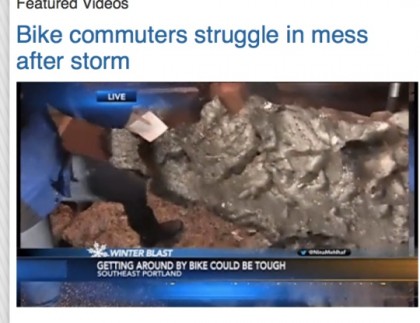
With the worst of the snow and ice storms behind us, the roads are slowly returning to normal. That is, unless you are trying to walk or bike.
As auto traffic volumes return to normal, people are finding that the conditions of bike lanes, neighborhood greenways, and off-street bike paths are full of a dangerous mix of slush, snow, and ice. This isn’t a surprise given that it’s the current policy of the Portland Bureau of Transportation (PBOT) to only plow major roads and arterials.
PBOT does not plow any bike-only areas including the paths across our major downtown bridges or facilities like the Springwater Corridor and Eastbank Esplanade. Separated bike paths — like NE Multnomah Street and the curbside bike lane on Broadway near Portland State University — are also left to fend for themselves. And on streets with bike lanes, plow trucks usually only clear the standard vehicles lanes while pushing the snow onto the area where people usually ride. (If you walk or roll your wheelchair, you’re at the mercy of adjacent property owners to shovel sidewalks.)
This lack of attention to key bicycle routes has resulted in poor riding conditions throughout the metro area. We reported about these concerns a bit yesterday and we’ve heard a lot more from readers since then. Before I share more from readers, I just noticed that KGW-TV featured a segment titled, Bicyclists have tough commute post-storm on their newscast last night.
Watch the video below:
Yesterday we asked folks to share their experience with the conditions. We got a lot of report in the comments to our story yesterday and via Twitter. We heard some reports of smooth sailing, but most people reported mountains of slush and snow and very difficult — if not impossible — conditions…
Slush tracks on the Hawthorne Bridge bike lane. @pdxcommute @BikePortland pic.twitter.com/lnZayFTODe
— Tessa Walker (@st_toast) February 11, 2014
I know PBOT's doing their best but this photo of the PSU cycletrack from @AlexLeeding speaks volumes about priorities pic.twitter.com/fK71UGf4Ej
— Aaron Brown (@ambrown) February 11, 2014
@BikePortland Lincoln was pretty hairy in the morning, still quite bad in the afternoon. The loose slush was far worse than the snow/ice.
— Dolan Halbrook (@dolanh) February 11, 2014
@BikePortland All side streets and bike lanes impassable even with the krampus in this slush.
— gabrielamadeus (@gabrielamadeus) February 11, 2014
@BikePortland Heavy slush, seemingly no thought of bikes or bike access. I was jealous of clear sidewalks downtown!
— Ms. Four (@msfour) February 11, 2014
@BikePortland SE Ankeny was horrible! Moved over to Glisan and took the (slush-free) lane.
— dudeluna (@dudeluna) February 11, 2014
@PDXParksandRec River level deck on Eastbank Esplanade is covered in slippery ice/slush. Please clear for bike commuters! @BikePortland
— Geoff Grummon (@ggrummon) February 11, 2014
Floating dock of the esplanade was the only tricky part of the commute this morning. #pdxcommute pic.twitter.com/iXgHh01Mj0
— showerspass (@showerspass) February 11, 2014
We also heard from several sources that the Springwater Corridor was nearly unpassable last night and into this morning.
For their part, PBOT has responded by referring folks to their snow plow map, telling people on bikes to be careful, and encouraging people to report specific hazard locations. Their responses on Twitter have included: “trying to make as much of a given road as passable as possible for all modes of transport” and “as we pick up sand, we’ll prioritize roads w/ dedicated bike lanes/ heavy bike traffic 4 safety”
This morning we were happy to see PBOT send out this tweet acknowledging reality:
Bicycling today? Roads are clear but expect gravel on street, bike lanes. Use caution while cleanup continues #pdxtraffic @BikePortland
— PDX Transportation (@PBOTinfo) February 11, 2014
It has become crystal clear in recent days that PBOT’s priority is to make sure the main roads are cleared first. That’s a reasonable policy, especially for a city (understandably) not fully equipped to handle snow and ice storms. But the abysmal condition of many key bikeways raises some important concerns. If Portland wants to be a place where bicycling is more attractive than driving (that’s the stated policy goal in adopted city plans), then bikeways should be given more attention during storm events.
One possible solution would be to simply add a few key bikeway connections to the city’s official Snow and Ice Priority Routes map (PDF). PBOT might also want to consider buying the snow removal attachment for their recently purchased bike lane sized street sweeper.
If there was at least one bike route through the central city and one route to each of the five quadrants that people could rely on — no matter what the weather — it would make a huge difference in safety and in the number of people who could safely travel during and after storms.
I realize there’s a tendency for PBOT and the public at large to say, “Come on bicyclists! The city is doing all it can. It’s just a few days. Deal with it!” I get that. But when it’s another few days in the fall when piles of leaves fill bike lanes and shoulders, and another few days when various festivals and events compromise important bikeways downtown, and another few days for inconvenient bike detours, and another few days for construction projects that spill into bike lanes, and another few days when debris and gravel make riding unsafe and unpleasant, it all adds up.
And it all adds up to people deciding they just don’t have the tolerance we require them to have in order to make bicycling their everyday mode of travel. It’s not just challenging weather that keeps people from biking, it’s how that weather exacerbates the already poor conditions that exist on far too many of our bikeways far too often.
I’d love to hear your thoughts.
— Read all our 2014 winter storm coverage here.

